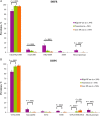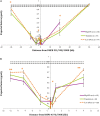Persistence of Sulfadoxine-Pyrimethamine Resistance Despite Reduction of Drug Pressure in Malawi
- PMID: 25672905
- PMCID: PMC4539899
- DOI: 10.1093/infdis/jiv078
Persistence of Sulfadoxine-Pyrimethamine Resistance Despite Reduction of Drug Pressure in Malawi
Abstract
Background: In 2007, Malawi replaced sulfadoxine-pyrimethamine (SP) with an artemisinin-based combination therapy as the first-line treatment for uncomplicated Plasmodium falciparum malaria in response to failing SP efficacy. Here we estimate the effect of reduced SP pressure on the prevalence of SP-resistant parasites and the characteristics of the associated selective sweeps flanking the resistance loci.
Methods: Samples obtained from individuals with clinical malaria during a period of high SP use (1999-2001), a transitional period (2007-2008), and a period of low SP use (2012) were genotyped for resistance markers at pfdhfr-ts codons 51, 59, and 108 and pfdhps codons 437, 540, and 581. Expected heterozygosity was estimated to evaluate the genetic diversity flanking pfdhfr-ts and pfdhps.
Results: An increase in the prevalence of the resistance haplotypes DHFR 51I/59R/108N and DHPS 437G/540E occurred under sustained drug pressure, with no change in haplotype prevalence 5 years after reduction in SP pressure. The DHPS 437G/540E/581G haplotype was observed in 2007 and increased in prevalence during a period of reduced SP pressure. Changes to the sweep characteristics flanking pfdhfr-ts and pfdhps were minimal.
Conclusions: In contrast to the rapid and complete return of chloroquine-susceptible falciparum malaria after chloroquine was withdrawn from Malawi, a reemergence of SP efficacy is unlikely in the near future.
Keywords: DHFR; DHPS; malaria; pyrosequencing; resistance; selective sweeps; sulfadoxine-pyrimethamine.
© The Author 2015. Published by Oxford University Press on behalf of the Infectious Diseases Society of America. All rights reserved. For Permissions, please e-mail: journals.permissions@oup.com.
Figures


References
-
- Laufer MK, Thesing PC, Eddington ND, et al. Return of chloroquine antimalarial efficacy in Malawi. N Engl J Med 2006; 355:1959–66. - PubMed
-
- Wootton JC, Feng X, Ferdig MT, et al. Genetic diversity and chloroquine selective sweeps in Plasmodium falciparum. Nature 2002; 418:320–3. - PubMed
-
- Kublin JG, Dzinjalamala FK, Kamwendo DD, et al. Molecular markers for failure of sulfadoxine-pyrimethamine and chlorproguanil-dapsone treatment of Plasmodium falciparum malaria. J Infect Dis 2002; 185:380–8. - PubMed
Publication types
MeSH terms
Substances
Grants and funding
LinkOut - more resources
Full Text Sources
Other Literature Sources

